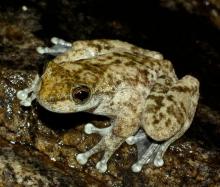You are here
Team hunts for ‘missing’ frogs

Researchers have discovered that species of rainforest frogs previously thought to be extinct are living outside their ‘normal’ range in dry sclerophyll forest.
Many rainforest frog populations were wiped out by the fungal disease chytridriomycosis in the 1980s and early 1990s. The critically endangered armored mist frog (Litoria lorica) was thought to be among them until discovered by James Cook University researcher Robert Puschendorf in 2008.
Dr Puschendorf, an ecologist and his colleague Dr Conrad Hoskin, an evolutionary biologist, are now collaborating on a NERP project to survey previously unexplored areas of dry forest on the western slopes of the Great Dividing Range to see whether other endangered rainforest species are living there. They are also surveying upland rainforest sites to see if threatened frogs are recolonising these areas. Until now, most researchers have focused on the rainforest and ignored these peripheral areas.
But, Dr Puschendorf explains, since the discovery of L. lorica and an unknown population of the waterfall frog (L. nannotis) thriving and co-existing with the chytrid fungus, they are hopeful of finding other populations and endangered species.
“We are excited about returning and doing systematic surveys to rule out whether other ‘missing’ species are there. Somehow the drier environment allows them to coexist with the chytrid fungus and hopefully we will find something else,” he says.
So far, much of their work has focused around the area where the population of L. lorica was discovered, in the hope of finding other populations of the frogs.
This is important, as Dr Hoskin explains. “While this is a healthy population with many individuals, it is still only one population so it is still critically endangered.
“It only needs one impact at that site and you could effectively be losing the species.”
The researchers will also survey around Eungella and the Wet Tropics to search for other endangered species, such as the gastric brooding frog.
Having visited all the sites they can by road, the researchers will now be surveying remote areas where they are dropped in by helicopter.
“We stay a couple of nights at each site which is enough to get a good overview, says Dr Puschendorf.
As well as looking for frogs, the pair will survey mammals, reptiles, birds and amphibians.
“So far, at these open sites, these otherwise endangered frog populations are incredibly abundant so we just need a couple of hours to walk along a creek to say whether or not they are there.”
The results of the surveys will be used to provide management recommendations and a list of critical areas that act as refuges for L. lorica and other endangered frogs.
Find out more about the project here
For more information contact: Robert Puschendorf or Conrad Hoskin
Latest News
- Laws protecting the Great Barrier Reef to be introduced next week, Queensland Premier says - Thu 28th May 2015
- Let’s get serious about protecting wildlife in a warming world - Thu 28th May 2015
- We’ve only monitored a fraction of the Barrier Reef’s species - Thu 28th May 2015
- Great Barrier Reef: warmer waters helping coral-eating starfish thrive - Fri 13th Feb 2015
- You are what you eat—if you're a coral reef fish - Wed 17th Dec 2014


